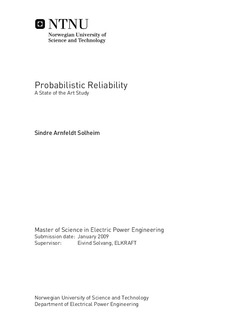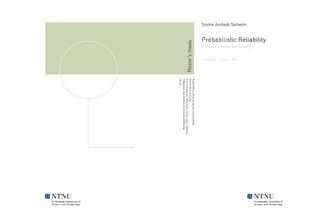| dc.description.abstract | Power system simulations, power market analysis as well as power system security and reliability analysis now serves as fundamental analysis tasks in power system planning and operation. Thus, it is very useful to discuss techniques, data needs and methodologies related power system reliability. Work is very important both in terms of operational and economical aspects of a modern power system. The task of determining the reliability of a given power system can be a complex and difficult process. Several methodologies exist and the terminology describing these calculations may differ from case to case. The work performed in this thesis demonstrates a known reliability methodology related to a real-life power system. In the latter, PSS®SINCAL and its reliability module ZUBER has been emphasized. The development of a working test model has been an important part of this thesis. In the latter, statistical information describing the power system has been the main challenge, both in terms of availability and quality. The various reliability data have been calculated from annual failure statistics collected by Statnett and experience data from Siemens. The scope of the reliability analysis was to determine the affect of future load expansions. It is a known fact that load development can affect the reliability of the power system and potentially increase the frequency of supply interruptions causing higher CENS costs. However, this was not the case as the changes in frequency of supply interruptions were insignificant. The results showed a suspected CENS cost increase of 1.6 NOK. Thus, it is evident that this is due to the fact that the uninterrupted power is now substantially larger. The reliability analysis show that the given power system will sustain its high level of reliability even with the planned load expansion. A comparative analysis of the ongoing development of a methodology (SAMREL) incorporating power market analysis via power flow and contingency analysis and PSS®SINCAL have also been presented. Comparing tools describing probabilistic reliability are important and can act as an incentive for future development of reliability tools. The major strength of PSS®SINCAL compared to SAMREL is simply the fact that PSS®SINCAL is a developed and commercialized tool. Unfortunately it was not possible conduct a reliability analysis using SAMREL, which was a major draw-back as a comparative analysis of both the tools relates to the same test model would have been very beneficial. SAMREL is comprised of several existing tools and therefore rely on the interaction between these tools, which after my opinion further complicate both the user friendliness and process of commercialization. From an educational point-of-view, the work related to SAMREL has several benefits contributing to increased general knowledge about power system reliability. It is evident that the accuracy of any reliability analysis depends on the quality of the statistical data. The studies show that local statistical data e.g. data based on local knowledge or local statistics often pose as a better solution. However, such data are unfortunately often very difficult to obtain, leaving no alternative as to use the available more general data. However, it is evident that some uncertainties always will exist but need to be taken into consideration when conducting such analysis. However, close cooperation with the utilities in combination with the utilization of high quality reliability data will after my opinion have a positive affect on the accuracy of the reliability analysis. Another important subject related to reliability is the process of identifying the critical system components. As shown, the main tool presented in this thesis is the consequence matrix, which categories the results obtained from the reliability analysis. The categories indicate both the consequence and the corresponding probability. Such matrixes need to be the result of a joint effort from both the customer and the professionals performing the criticality analysis, including all relevant information needed to classify criticality. The strength of this method lies in the fact that the defined probabilities can be used to identify large elements, such as substations and then be further utilized on a component level for the critical substation. The methodologies describing power system reliability have been emphasized throughout this thesis. The given test system and the performed reliability calculation demonstrates PSS®SINCAL as a tool for determining the reliability of a power system. The methodology utilized in this report is from the author s point of view a good representation of a state of the art reliability analysis. | nb_NO |

